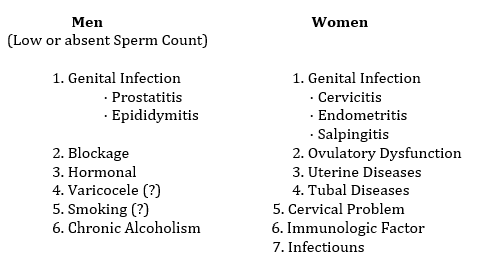


My experience in treating Infection- related Infertility has shown that this can affect practically everyone, even those with already proven Fertility because the cumulative effect of injury to our reproductive system from an infection is bound to catch up on us.
This explains why some couples who had ease in having their first child may have difficulty in their second or later attempts at bearing a child. This also holds true with couples who elect to have a child at a later age.
It is important for men and women in their reproductive ages to know more about Infection-related Infertility. This knowledge may aid them in how to protect and preserve their Reproductive Capability.
Infertility
Is defined as a condition where a couple fails to conceive after one year of regular sexual contact without contraception.
Fecundity Patterns of Normal Fertile Couple
One survey stated that 75% will conceive in six months and 90% will conceive in one year (Taylor, 2003).
From a proactive point of view, one year of waiting is quite long to suspect that there may be something wrong with a couple who aspires to have a child and yet fails. I believe that three menstrual cycles may be long enough for a woman to conceive if there is no apparent problem or obstacle hounding her or her partner.
Optimum Fertility Age for Women
20 - 29 y/o -----------85%
30 - 35 y/o -----------63%
36 - 39 y/o-----------52%
Causes of Decline of Fertility in Women
1. The cumulative effect of injury from infection
2. The effect of aging on the quality of the oocyte or egg.
Through the years of treating Infertility, I came to realize how a Genital Infection such as Prostatitis in men and Cervicitis in women could play a major role in infertility.
Genital Infection is said to be the most common cause of Infertility in men and women (Jewelewicz & Wallach, 1995). Accordingly, Genital Infection may cause infertility, ectopic pregnancy, recurrent spontaneous abortion, stillbirth, neonatal death and blockage of the Fallopian Tubes in women and Epididymis in men.
Since Infection-related Infertility is said to be the most common cause of Infertility, then a complete work-up for Genitourinary Infection should be the first step in the evaluation of an Infertile Couple. But ironically, it is not being routinely done.
Steps in Diagnosis of Infertility
- History and Physical Examination
- Complete Genitourinary work-up for infection
- Gram Stain
- Chlamydia Immunofluorescence test by Direct Fluorescence Antibody (DFA)
- Comprehensive Culture and Sensitivity Tests to include Ureaplasma and Mycoplasma Cultures
- Semen Analysis for men including Cultures
- Assessment of ovulatory function: A more objective parameter is by way of a test called Follicular Monitoring through a series of Transvaginal Ultrasounds. This could also diagnose an ovulatory problem called Polycystic Ovary (PCO).
- Hormonal work-up (Men and Women)
- Assessment of cervical factors
- Post-coital test (PCT)
- Assessment of Uterine and tubal function by Hysterosalpingogram or Laparoscopy, when called for, should be done only after a woman has been cleared of Genital Infection (Cervicitis). Otherwise, injecting a fluid (Dye) into the Cervix could push an infection from the Cervix into the Fallopian Tubes that might also cause an infection called Salpingitis which could lead to scarring and result in a partial or total blockage of the tube/s. Due prudence should be exercised in assessing tubal function.

Health Topics
-----













